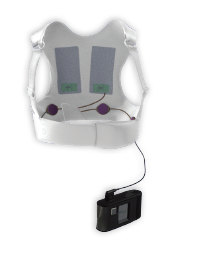Wearable Defibrillators

Unlike an implantable cardioverter defibrillator (ICD), the LifeVest is worn outside the body rather than implanted in the chest. This device continuously monitors the patient's heart with dry, non-adhesive sensing electrodes to detect life-threatening abnormal heart rhythms. If a life-threatening rhythm is detected, the device alerts the patient prior to delivering a shock, and thus allows a conscious patient to disarm the shock. If the patient is unconscious, the device releases a liquid gel over the therapy electrodes and delivers an electrical shock to restore normal rhythm.
The wearable defibrillator is a treatment option for patients who are at high risk for sudden cardiac arrest (SCA) or sudden cardiac death (SCD). Potential patient groups who may benefit from the technology include:
- Post-myocardial infarction (MI) patients with complications
- Cardiac surgery patients with complications
- Heart transplant waiting list patients
- Advanced heart failure patients
- Patients undergoing drug loading with potentially pro-arrhythmic medications
- Patients who need an ICD, but have a condition that prevents or delays surgery (such as an infected ICD pocket)
- Patients who simply do not want to undergo surgery or have an implant
The LifeVest was designed as an intermediate-term treatment option for people at high risk for SCA. Right now, people at a high, short-term risk of SCA are typically monitored in a hospital intensive care unit (ICU) or coronary care unit (CCU). With monitored beds costing up to $2,000 a day, this option quickly becomes very expensive and is primarily reserved for critical-care patients.
Patients with a high, long-term risk of SCA are often candidates for an implantable cardioverter defibrillator (ICD), but this option is also expensive (up to $65,000) and requires surgery. According to Morgan Stanley, only one out of six U.S. patients who need an ICD actually get one.
The LifeVest fills the therapeutic gap between hospitalization and an ICD. The LifeVest has the same important characteristics of both an ICU/CCU and the ICD; it continuously monitors the heart and is designed to provide prompt defibrillation when needed. It is believed that the wearable defibrillator has the potential to become the standard of care for intermediate-term patients at risk. And, in cases when an ICD is not feasible, it also can serve as a longer-term alternative.
Numerous patients have worn the wearable defibrillator and approximately 98% have been successfully rescued from a life-threatening episode of VF/VT.

Timely response is a key factor for all victims of cardiac arrest. With each passing minute before resuscitation, the chance of survival decreases by 10%.1 Even in the hospital setting, often there can be a delay to defibrillation. This is not a matter of poor performance; it is the nature of the cardiac arrest and the physical ability to respond immediately, given traditional hospital detection and response systems.
In 2017, ZOLL introduced a wearable defibrillator designed specifically for in-hospital use. The Hospital Wearable Defibrillator (HWD) constantly monitors the patient, automatically detects life-threatening arrhythmias, and provides immediate treatment. This allows the hospital care team to provide patients at risk of cardiac arrest with continuous protection. The HWD utilizes the same detection algorithm and defibrillation waveform as the LifeVest wearable defibrillator.
The HWD is designed to treat within 60 seconds. It utilizes adhesive defibrillation and ECG electrodes, and it provides messages designed specifically for patients and for nurses. The HWD is a care option for protecting patients continuously – anytime, day or night, in the hospital.
1Larsen MP, et al. Ann Emerg Med. 1993;22: 1652–58.